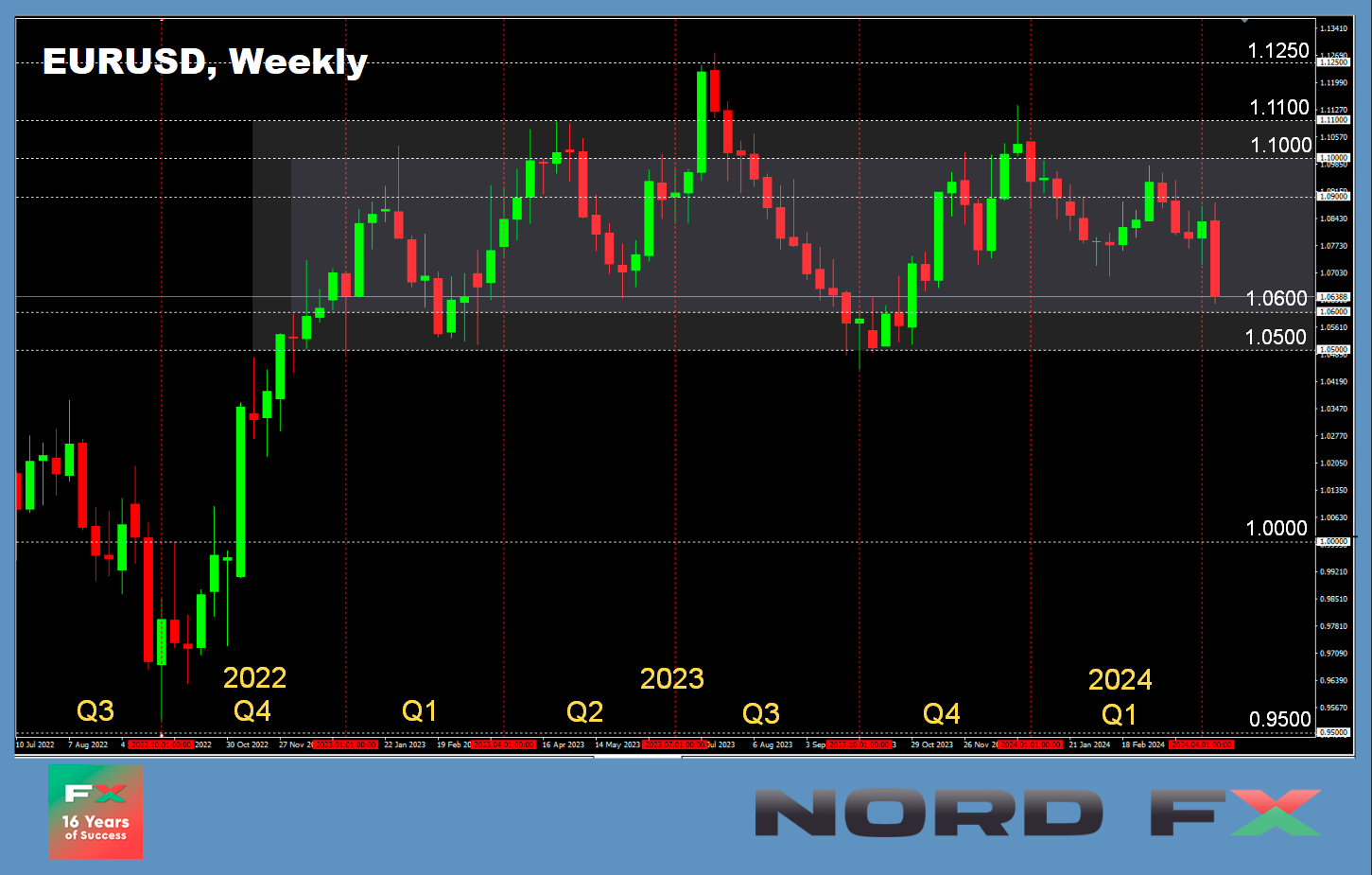Forex and Cryptocurrency Forecast for 15 – 19 April 2024 – Analytics & Forecasts – 13 April 2024


EUR/USD: The Dollar Soars

● Last week saw two significant events: the first shocked market participants, while the second passed without surprises. Let’s examine the details in order.
Since mid-2022, consumer prices in the US have been declining. In July 2022, the Consumer Price Index (CPI) was at 9.1%, but by July 2023, it had fallen to 3.0%. However, in October, the CPI rose to 3.7%, then decreased again, and by February 2024, it had dropped to 3.2%. As a result, there was a general perception that inflation had finally been brought under control. The market consensus was that the Federal Reserve would soon begin to ease its monetary policy and start reducing interest rates in June. Two weeks ago, the likelihood of this move was estimated at 70%. The DXY index began to fall, reaching a local low of 103.94 on 9 April. However, the dollar bears’ joy was short-lived, as fresh US inflation data released on Wednesday, 10 April, quickly changed the sentiment.
● In annual terms, the Consumer Price Index (CPI) rose to 3.5%, marking the highest level in six months. The main drivers of this inflation increase were the rises in rental costs (5.7%) and transportation expenses (10.7%), which clearly caught the markets by surprise. The chances of a rate cut in June plummeted to zero, and the DXY dollar index soared, reaching a peak of 105.23 on the evening of 10 April. Alongside this, the yield on 10-year US Treasury bonds grew to 4.5%. As is typical in such scenarios, stock indices such as the S&P 500, Dow Jones, and Nasdaq declined, and the EUR/USD pair, after dropping over 150 points, fell to 1.0728.
● Austan Goolsbee, President of the Chicago Federal Reserve Bank, stated that although the regulator is confidently moving towards its 2.0% inflation target, the Federal Reserve leadership still has much work to do to reduce inflation. His colleague, John Williams, President of the New York Fed, noted that the latest inflation data were disappointing and added that economic prospects remain uncertain.
As a result of these and other statements, it is now forecasted that the Fed will begin cutting interest rates only in September. Moreover, investors expect there will be only two rate cuts this year, not three. Some believe that there may not be any rate cuts at all in 2024. However, according to US President Joe Biden, the Fed should still lower the rate in the second half of this year. His insistent request is quite understandable on the eve of the presidential elections. Firstly, it would reduce the cost of servicing the country’s enormous national debt, and secondly, it would symbolize a victory over inflation, giving Biden several additional points in the battle for the White House.
● After the American inflation reaction, markets took a brief pause, awaiting the European Central Bank (ECB) governing council meeting on 11 April. The ECB has held rates steady at 4.50% since September 2023, which was in line with market expectations as forecasted by all 77 economists surveyed by Reuters. Thus, after some fluctuation, EUR/USD returned to its pre-ECB meeting level.
● The ECB press release affirmed the council’s firm intention to return inflation to a medium-term target of 2.0% and believed that the key rates contribute significantly to the ongoing disinflation process. Future decisions will ensure that the key rates remain at sufficiently restrictive levels as long as necessary.
● It’s worth noting that inflation in the 20 Eurozone countries was at 2.4% in March, slightly above the target of 2.0%. In February, the rate was 2.6%, and in January it was 2.8%. Economists surveyed by Reuters believe that inflation will continue to decrease in the coming quarters, but it will not reach 2.0% before the second quarter of 2025.
Christine Lagarde, the head of the European Central Bank (ECB), expressed a similar view during a press conference. However, she mentioned that since the Eurozone economy remains weak, to support it, the ECB will not wait for inflation to return to the 2.0% level at every point. Thus, Ms. Lagarde did not rule out that the regulator might start easing its monetary policy significantly before 2025. Strategists from the Italian bank UniCredit forecast that the ECB will cut rates three times this year, by 25 basis points each quarter. The pace of reduction could remain the same next year. Economists from Deutsche Bank also expect that the pan-European regulator will start cutting rates before the Federal Reserve and will do so at a faster pace. Consequently, the widening interest rate differential between the US and the Eurozone will contribute to the weakening of the euro.
● This medium-term forecast was confirmed last Friday: EUR/USD continued its decline, reaching a local minimum of 1.0622 and closing the five-day period at 1.0640. The DXY index peaked at 106.04. As for the near-term outlook, as of the evening of 12 April, 40% of experts anticipate an upward correction of the pair, while the majority (60%) hold a neutral position. Among the oscillators on D1, only 15% are coloured green, and 85% are red, although a quarter of them are in the oversold zone. Trend indicators are 100% bearish. The nearest support levels for the pair are located in the zones 1.0600-1.0620, followed by 1.0495-1.0515, 1.0450, 1.0375, 1.0255, 1.0130, and 1.0000. Resistance zones are situated at levels 1.0680-1.0695, 1.0725, 1.0795-1.0800, 1.0865, 1.0895-1.0925, 1.0965-1.0980, 1.1015, 1.1050, 1.1100-1.1140.
● Next week, on Monday, 15 April, US retail sales data will be released. On Wednesday, it will become clear what is happening with consumer inflation in the Eurozone. It is likely that the refined data will confirm the preliminary results, and the Consumer Price Index (CPI) for March will be reported at 2.4% year-on-year. On Thursday, we traditionally expect data on the number of initial jobless claims from US residents and the Philadelphia Fed Manufacturing Index.

GBP/USD: The Pound Plummet
● On Friday, 12 February, the UK’s GDP data indicated that the economy is on the path to recovery. Although production has declined compared to last year, the latest data suggests that exiting the shallow recession is quite likely. GDP has grown for the second consecutive month, with the Office for National Statistics (ONS) reporting a 0.1% increase in February on a monthly basis, with January’s figures revised upwards to show a 0.3% growth from an earlier 0.2%.
● Despite these figures, GBP/USD fell below the key 1.2500 mark due to crumbling hopes for an imminent Fed rate cut. Not even a statement from Bank of England (BoE) Monetary Policy Committee member Megan Greene, which highlighted that inflation risks in the UK remain significantly higher than in the US and that markets are mistaken in their rate cut forecasts, could change the situation. “Markets have leaned towards the Fed not cutting rates so soon. In my view, the UK will also not see rate cuts anytime soon,” she wrote in her Financial Times column.
Following Greene’s remarks, traders now expect no more than two rate cuts from the Bank of England this year, each by 25 basis points. However, this revised forecast did little to support the pound against the dollar, with GBP/USD ending the week at 1.2448.
● Analysts are split on the short-term behaviour of GBP/USD: 50% voted for a rebound to the north, and 50% abstained from forecasting. Indicator readings on D1 suggest the following: among oscillators, 10% recommend buying, another 10% are neutral, and 80% indicate selling, with 20% of these signalling oversold conditions. All trend indicators are pointing downwards. If the pair continues south, it will encounter support levels at 1.2425, 1.2375-1.2390, 1.2185-1.2210, 1.2110, and 1.2035-1.2070. In the event of an increase, resistance will be found at levels 1.2515, 1.2575-1.2610, 1.2695-1.2710, 1.2755-1.2775, 1.2800-1.2820, 1.2880-1.2900, 1.2940, 1.3000, and 1.3140.
● The most significant days for the British currency next week will be Tuesday and Wednesday. Extensive labor market data from the United Kingdom will be released on Tuesday, 16 April, along with a speech from the Governor of the Bank of England, Andrew Bailey. Wednesday, 17 April, could be even more turbulent and volatile as consumer inflation (CPI) data for the country will be published.

USD/JPY: Is 300.00 Just a Matter of Time?
● Bears on USD/JPY continue to hope for its reversal southwards, yet the pair does not stop climbing. Our previous review titled “A Break Above 152.00 – A Matter of Time?” proved true within a very short period. Last week, the pair reached a 34-year high of 153.37, propelled by US inflation reports and increases in the DXY index and yields on 10-year US treasuries. (Considering that it traded above 300.00 in 1974, this is still not the limit).
● This surge occurred despite another round of verbal interventions from high-ranking Japanese officials. Finance Minister Suzuki Shunichi reiterated his concern over excessive currency movements and did not rule out any options to combat them. Cabinet Secretary Yoshimasa Hayashi echoed these sentiments almost verbatim. However, the national currency no longer pays any attention to such statements. Only real currency interventions and significant steps towards tightening monetary policy by the Bank of Japan (BoJ) could help, but these have yet to occur.
● Analysts at Dutch Rabobank believe the Japanese Ministry of Finance will eventually be forced to act to prevent the price from reaching 155.00. “While a breakthrough of the 152.00 level by USD/JPY might not immediately trigger currency interventions, we see a significant likelihood of such a step,” they write. “Assuming that the Bank of Japan may announce a second rate hike later this year and considering expectations that the Fed will indeed cut rates in 2024, Rabobank expects USD/JPY to trade around 150.00 on a monthly horizon and 148.00 on a 3-month horizon.”.
● Last week, the pair closed at 152.26. Regarding its near future, 25% of experts sided with the bears, another 25% remained neutral, and the remaining 50% voted for further strengthening of the US currency and a rise in the pair. Technical analysis tools are apparently unaware of the fears regarding possible currency interventions, so all 100% of trend indicators and oscillators on D1 are pointing north, with a quarter of them now in the overbought zone. The nearest support level is around 152.75, followed by 151.55-151.75, 150.80-151.15, 149.70-150.00, 148.40, 147.30-147.60, and 146.50. Defining resistance levels after the pair updated 34-year highs is challenging. The nearest resistance lies in the zone 153.40-153.50, followed by levels 154.40 and 156.25. According to some analysts, the monthly high of June 1990 at around 155.80 and then the reversal high of April 1990 at 160.30 can also serve as references.
● No significant events or publications regarding the state of the Japanese economy are planned for the upcoming week.

CRYPTOCURRENCIES: On the Eve of Hour X
● The next halving, when the reward for mining a BTC block will again be halved, is scheduled for Saturday, 20 April. Although this date is approximate and may shift a day or two either way, the closer the Hour X, the hotter the discussions about how the price of the main cryptocurrency will behave before and after this event.
Historically, the value of bitcoin has risen after halvings: it surged by nearly 9000% to $1162 in 2012, by about 4200% to $19800 in 2016, and by 683% to $69000 following the previous halving in May 2020. However, it then crashed to nearly $16,000.
● Lucas Kiely, CIO of the financial platform Yield App, believes that we should not expect a seven-fold increase in the price of bitcoin after the upcoming halving. According to Kiely, during the three previous cycles, the halving of miners’ rewards heralded a massive increase in volatility levels. After the halving, BTC fell by 30-40% but then soared to unprecedented heights within 480 days. However, this year, he suspects, the cryptocurrency’s flight to the Moon will not occur.
Kiely predicts that bitcoin will update its historical maximum reached this March at $73,743. However, the new peak will not exceed the previous one by as much as before, due to the low level of volatility. The specialist attributes the drop in volatility to two factors: 1. an increase in the number of bitcoins in the wallets of hodlers, who own more than 70% of the issued coins, and 2. the creation of spot Bitcoin ETFs, which remove a huge amount of coins from circulation. (In the three months since their inception, the capitalization of 10 such ETFs (excluding the Grayscale fund) has exceeded $12 billion). As a result, bitcoin is becoming a more traditional asset that is less risky but also less likely to yield massive profits. Kiely believes that this factor makes the coin more attractive to institutional investors and older people who prefer to invest in reliable assets and are not interested in gambling.
● Ex-CEO of the BitMEX exchange, Arthur Hayes, expects a price drop. In his view, the halving is certainly a bullish catalyst for the crypto market in the medium term. However, prices might fall immediately before and after the event. “The narrative that the halving of block rewards will positively affect cryptocurrency prices has firmly taken root,” says the expert. “However, when most market participants agree on a certain outcome, the opposite usually happens.”
Hayes noted that the market would face a reduction in US dollar liquidity in the second half of April, driven by tax season, Fed policies, and the strengthening of the US Treasury’s balance sheet. This reduction in liquidity will provide additional stimulus for a “furious sell-off of cryptocurrencies,” he believes. “Can the market defy my bearish forecasts and continue to grow? I hope so. I have been involved with cryptocurrency for a long time, so I welcome being proven wrong.”
● The situation before this halving is indeed very different from before. This change is linked to the large influx of institutional investors through the newly launched Bitcoin ETFs in early January. The influence of ETFs on spot trading is clearly reflected in the reduced market activity on weekends and US public holidays when the exchange funds do not operate. The tax season has also significantly impacted the market for risky assets. Over the last two weeks, inflows into these funds have been significantly below the average mark of $203 million, with recent days seeing an outflow of funds from Grayscale and Ark Invest. Other ETFs are also reporting reduced inflows. All this suggests that Arthur Hayes’ concerns are well-founded, and a 30% drop from the current price could send bitcoin down to around $50,000.
Miners, who will lose half their income after the halving, while the costs of obtaining the same amount of coins will increase, could also contribute to a market crash. After the halving in May 2020, the costs of mining rose to $30,000. Currently, the average cost of mining one BTC is $49,900, but after 20 April, according to Ki Young Ju, CEO of the analytical platform CryptoQuant, it will exceed $80,000. Therefore, the asset must trade above this level for miners to continue making any profit. However, as previously mentioned, a rapid price surge may not occur. This means that small mining companies and individual miners are facing a wave of bankruptcies and acquisitions.
● According to Arthur Hayes, the situation might improve in May-June: the US Treasury will “most likely release an additional $1 trillion of liquidity into the system, which will pump the markets,” he says. Anthony Scaramucci, CEO of Skybridge, also holds that spot Bitcoin ETFs, acting as “selling machines,” will continue to stimulate demand for the first cryptocurrency from both retail customers and institutional investors. Scaramucci believes that in this cycle, bitcoin’s value could increase by 2.5 times, and then continue to rise. “I’m just saying that the capitalization of bitcoin could reach half that of gold, i.e., increase six or even eight times from its current levels,” the businessman declared. It’s noteworthy that the current capitalization of bitcoin stands at $1.35 trillion, while gold’s is at $15.8 trillion. Thus, if BTC reaches half the capitalization of the precious metal, its price would be around $400,000 per coin.
Brad Garlinghouse, CEO of Ripple, also places his hopes on spot Bitcoin ETFs. According to him, BTC-ETFs have attracted real institutional investments into the industry for the first time, so he is “very optimistic” about the macroeconomic trends in the crypto industry. In this context, Garlinghouse allowed that the market capitalization of digital assets could double by the end of the year, exceeding $5.0 trillion.
● As of the evening of Friday, 12 April, BTC/USD is trading at around $66,900. The total capitalization of the crypto market is $2.44 trillion ($2.53 trillion a week ago). The Crypto Fear and Greed Index remains in the Extreme Greed zone at 79 points.
● In conclusion, a bit of curious statistics: In anticipation of the halving, Deutsche Bank conducted a survey regarding the future price of bitcoin. 15% of respondents stated that within this year, BTC would trade in the range above $40,000 but below $75,000. A third of respondents were confident that the value of the main cryptocurrency would fall below $20,000 early in the next year. Meanwhile, 38% of those surveyed believed that BTC would cease to exist in the market altogether. And finally, about 1% of respondents called bitcoin a complete misunderstanding and speculation.
NordFX Analytical Group
https://nordfx.com/
Notice: These materials are not investment recommendations or guidelines for working in financial markets and are intended for informational purposes only. Trading in financial markets is risky and can result in a complete loss of deposited funds.
#eurusd #gbpusd #usdjpy #Forex #forex_forecast #signals_forex #cryptocurrency #bitcoin #nordfx



